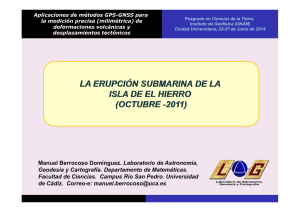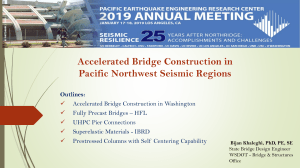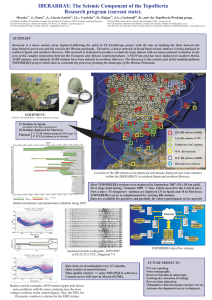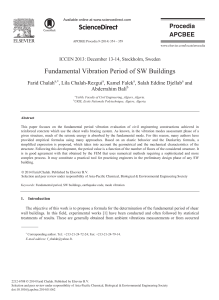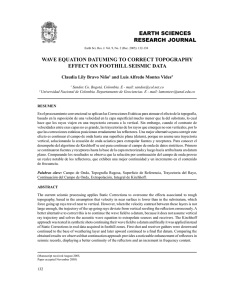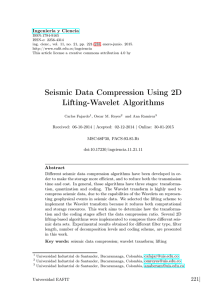Caribbean Uniform Building Code (CUBiC)
Anuncio
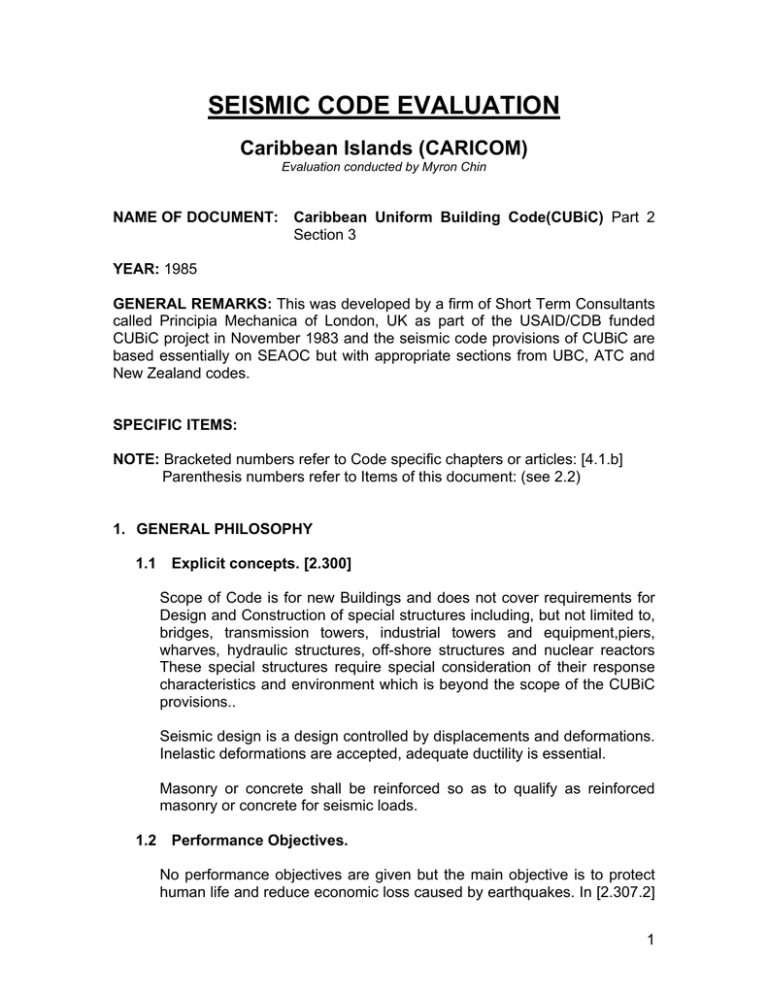
SEISMIC CODE EVALUATION Caribbean Islands (CARICOM) Evaluation conducted by Myron Chin NAME OF DOCUMENT: Caribbean Uniform Building Code(CUBiC) Part 2 Section 3 YEAR: 1985 GENERAL REMARKS: This was developed by a firm of Short Term Consultants called Principia Mechanica of London, UK as part of the USAID/CDB funded CUBiC project in November 1983 and the seismic code provisions of CUBiC are based essentially on SEAOC but with appropriate sections from UBC, ATC and New Zealand codes. SPECIFIC ITEMS: NOTE: Bracketed numbers refer to Code specific chapters or articles: [4.1.b] Parenthesis numbers refer to Items of this document: (see 2.2) 1. GENERAL PHILOSOPHY 1.1 Explicit concepts. [2.300] Scope of Code is for new Buildings and does not cover requirements for Design and Construction of special structures including, but not limited to, bridges, transmission towers, industrial towers and equipment,piers, wharves, hydraulic structures, off-shore structures and nuclear reactors These special structures require special consideration of their response characteristics and environment which is beyond the scope of the CUBiC provisions.. Seismic design is a design controlled by displacements and deformations. Inelastic deformations are accepted, adequate ductility is essential. Masonry or concrete shall be reinforced so as to qualify as reinforced masonry or concrete for seismic loads. 1.2 Performance Objectives. No performance objectives are given but the main objective is to protect human life and reduce economic loss caused by earthquakes. In [2.307.2] 1 DUCTILITY- The building as a whole, and all of its elements that resist seismic forces or moments, or that in case of failure are a risk to life, shall be designed to possess ductility. 2. SEISMIC ZONING AND SITE CHARACTERIZATION 2.1 Seismic Zoning. [2.305.4 and Table 2.305.1] THE VARIOUS ISLANDS OF THE ENGLISH SPEAKING CARIBBEAN ARE ASSIGNED ZONAL COEFFICIENTS ,Z, IN TABLE 2.305.1. 2.2 TERRITORY Z VALUE JAMAICA ANTIGUA ST.KITTS-NEVIS MONTSERRAT DOMINICA ST.LUCIA ST.VINCENT GRENADA BARBADOS NW TRINIDAD REST OF TRINIDAD TOBAGO GUYANA ESSEQUIBO REST OF GUYANA BELIZE –AREAS WITHIN 100KM OF SOUTHERN BORDER I.E. INCLUDING SAN ANTONIO AND PUNTA GORDA BUT EXCLUDING MIDDLESEX, POMONA AND STANN CRECIL - REST OF BELIZE .75 .75 .75 .75 .75 .75 .50 .50 .375 .75 .50 .50 .25 .00 .75 .50 Levels of Seismic Intensity. No levels of Seismic Intensity given in the code. 2.3 Near Fault considerations. Not considered. 2 2.4 Site Requirements 2.5 Site Classification. [2.305.8] The value of the soil factor, S, shall be determined by the following formulae but shall not be less than 1.0: For T/Ts= 1.0 or less, S= 1.0 + T/Ts – 0.5 T2/Ts For T/Ts greater than 1.0, S= 1.2 + 0.6 T/Ts – 0.3 T2/ Ts T shall be established by properly substantiated analysis but T shall not be taken as less than 0.3 seconds. The range of values of Ts may be established from properly substantiated geological data, except that Ts shall not be taken as less than 0.5 seconds nor more than 2.5 seconds. Ts shall be that value within the range of site periods as determined above that is nearest to T. Where T has been established by a properly substantiated analysis and exceeds 2.5 seconds, the value of S may be determined by assuming a value of 2.5 seconds for Ts. 2.6 Peak Ground Accelerations. Effective Peak Ground Accelerations are not defined. 3. PARAMETERS FOR STRUCTURAL CLASSIFICATION 3.1 Occupancy and Importance. [2.305.6] Three Classes, with corresponding Importance Factors I are given: Class I Buildings: I = 1.5 These are Essential Facilities required for use in the aftermath of a major earthquake, e.g. hospitals, fire stations, communication centers etc. Class II Buildings: I = 1.2 These are public buildings and buildings which accommodate large numbers of people, e.g. cinemas, theatres, schools, defence establishments etc. Class III Buildings: I= 1.0 All other buildings not included in Class I or class II above. 3.2 Structural Type. [Table 2.305.2] Nine Structural Types for Steel and Concrete and Three for Timber. 3 Frame Type (Ductile steel, concrete, timber). Dual Type (Frame + Wall combination. Frame with 25% of shear demand; steel, concrete, masonry, timber) Wall Type (either concrete, masonry or plywood walls or steel or timber braced frames) Cantilever Type (or Inverted Pendulum) Others Type (none of the above) 3.3 Structural Regularity: Plan and Vertical. [2.304.2] Buildings which have highly irregular shapes, large differences in lateral resistance or stiffness between adjacent storeys, or unusual features shall be analysed by dynamic methods. In particular, buildings classified in Importance Groups I and II shall be analysed by dynamic methods when: (a) the seismic force resisting system does not have the same configuration in all storeys and in all floors. (b) The floor masses differ by more than 30% in adjacent floors. (c) The cross-sectional areas and moments of inertia of structural members differ by more than 30% in adjacent stories. 3.4 Structural Redundancy. Not considered 3.5 Ductility of elements and components. [2.307.2] Clauses 2.307.2 to 2.307.18 cover the ductility requirements of the various types of frames. 4. SEISMIC ACTIONS 4.1 Elastic Response Spectra. Not considered. 4.2 Design Spectra Not considered. 4.3 Representation of acceleration time histories Not considered. 4.4 Design Ground Displacement Not considered. 4 5. DESIGN FORCES, METHODS OF ANALYSIS AND DRIFT LIMITATIONS [2.305, 2.305.17, 2.306] 5.1 Load Combinations including Orthogonal Seismic Load Effects Load Combinations not mentioned but drift provisions given in clause 2.305.17 which states as follows: “Lateral deflections or drift of a storey relative to its adjacent stories shall not exceed 0.005 tiimes the storey height unless it can be demonstrated that greater drift can be tolerated. The displacement calculated from the application of the required lateral forces shall be multiplied by 1.0/K to obtain the drift. The ration 1.0/K shall not be less than 1.0.” 5.2 Simplified Analysis and Design Procedures None given. 5.3 Static Method Procedures. [2.305] V = ZCIKS W where V Z C = Total Lateral Force or Shear at the base = Seismic Zonal Coefficient (see 2.1) = 1/15√T C need not exceed 0.12 For moment resisting structures where the frames are not enclosed or adjoined by more rigid components tending to prevent the frames from deflecting when subjected to seismic forces: T= CThn3/4 Where CT= 0.035 for steel frames CT= 0.025 for concrete frames hn= the height in feet above the base to the highest level of the building For all other buildings: T= 0.05hn/√L 5 Where L = the overall length (in feet) of the building at the base in the direction under consideration. W= Total Weight (100% of Permanent (Dead) Load + applicable portions of other loads. Force distribution in proportion to each floor weight, Wi , and height, hi . Fi = V [ wi hik / Σ Wk hkk ] Where k is an exponent related to the building period as follows: For buildings having a period of 0.5 seconds or less, k=1 For buildings having a period of 2.5 seconds or more, k=2 For buildings having a period between 0.5 and 2.5 seconds, k may be 2. Natural Period calculated with Rayleigh Method 5.4 Mode Superposition Methods. [2.306] Required whenever Static Method Procedures (see 5.3) are not allowed. Combination of modes according to SRSS . 5.5 Non Linear Methods. No Non linear methods of analysis are mentioned as alternative methods. 5.6 Torsional considerations. [2.305.14] All structures with Plan Structural Irregularities (see 3.3) where the vertical resisting elements depend on diaphragm for shear distribution at any level, the shear resisting elements shall be capable of resisting a torsional moment assumed to be equivalent to the storey shear acting at an eccentricity of not less than five percent of the maximum dimension at that level.. 5.7 Drift Limitations. [2.305.17] See ( 5.1) 5.8 Soil-Structure Interaction Considerations. Not considered 6 6. SAFETY VERIFICATIONS 6.1 Building Separation Not considered 6.2 Requirements for Horizontal Diaphragms Not considered 6.3 Requirements for Foundations [2.307.22] Individual Pile Caps and caissons of every building shall be interconnected by ties each of which can carry by tension and compression a minimum horizontal force equal to 10 percent of the largest pile cap or caisson loading, unless it can be demonstrated that equivalent restraint can be provided by other approved methods. 6.4 P-Delta Considerations Not considered 6.5 Non-Structural Components Not considered 6.6 Provisions for Base Isolation Not considered 7. SMALL RESIDENTIAL BUILDINGS Not considered in CUBiC but the draft Small Building Code of Trinidad and Tobago (SBCTT) has a number of sections which deal with Lateral Load Design for earthquakes in Sections 3.1.7 and 3.2.6 on pages 16 to 21 and 42 to45. These pages can be viewed at URL: http://www.boett.org In the preparation of this SBCTT, extensive use has been made of the Caribbean Uniform Building Code (CUBiC). It was noted that at this time CUBiC is being considered for revision and the management committee for the revision project has elected to make use of the International Code Council Inc. of the USA in the provision of the base documentation for this review. In like manner for this code use has been made of the ICC year 2000 International Residential Code Final Draft 1998. 7 The exercise was managed by the Board of Engineering of Trinidad and Tobago sponsored by the Joint Consultative Council of the Construction Industry (T&T) and the Interim National Physical Planning Commission (T&T) with support of the Trinidad and Tobago Bureau of Standards (TTBS). 8. PROVISIONS FOR EXISTING BUILDINGS Not considered CODE IMPROVEMENT RECOMMENDATIONS The CUBiC Seismic Code can be considered as being a very outdated Code since no updating has taken place since it was produced in 1985. It is therefore recommended that it be replaced with a more modern seismic code such as IBC 2000 incorporating updated seismic hazard maps for the English speaking Caribbean region in a Caribbean Application Document (CAD). In respect of Chapter 7 on Small Residential Buildings it is recommended that the Small Building Code of TT be adopted. 8


